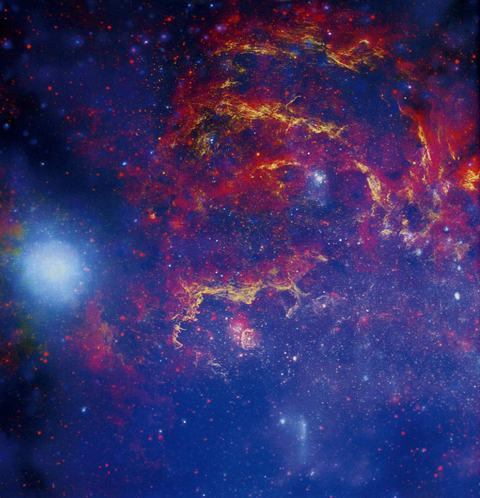Humans can only see a small portion of the electromagnetic spectrum. We have powerful telescopes that reveal remote galaxies, but not even the Hubble Space telescope can reveal everything that is out there. There are objects, such as brown dwarfs, that are too cool to give off visible light. They do, however, emit energy in an invisible form -- longer wavelengths known as infrared radiation.
Incredibly hot objects, such as massive exploding stars, give off much of their energy in shorter, invisible wavelengths like gamma rays and X-rays.
Now scientists have developed other telescopes that can “see” these other wavelengths. At this time there are a trio of space telescopes returning to us amazing and beautiful images --Hubble, which sees in the visible light spectrum, Chandra which studies X-rays, and Spitzer which is the infrared telescope. Scientists assign false colors to the different wavelengths the telescopes detect, and when a portion of the sky is viewed in different wavelengths, one gets a completely different picture. As a scientist put it, “They are all pieces of a puzzle.”
One of the three space-based telescopes is the Chandra X-ray observatory shows gas heated by explosions.
The Hubble Space telescope is tuned to the near infra-red, which is visible to the naked eye.
The Hubble telescope reveals active areas of star formation.
Chandra excels at capturing chaos. This photo shows a blast of debris expanding at millions of miles an hour. It is the result of a supernova that became visible to us some 300 years ago.
This is the spiral galaxy NGC 4258. The two ghostly blue arms contain gasses heated by violent shock waves. Taken by the Chandra telescope.
These images are wonderful to behold. Some seem almost psychedelic, others more delicate. This image from Chandra appears almost spectral, and scientists refer to it as “The Hand of God”.
The Spitzer focuses on infrared radiation emanating from heated dust. The dark green is a structure slicing through a spiral arm of the Milky Way galaxy.
The dark streak almost dead center may be a ripple of star formation. This was also from the Spitzer.
Here is the center of our own galaxy shown as a composite of all three space-based telescopes.
Humor --
Bizarre Classified Ads
Lost: small apricot poodle. Reward. Neutered. Like one of the
family.
A superb and inexpensive restaurant. Fine food expertly served by
waitresses in appetizing forms.
Dinner special - Turkey $2.35; Chicken or Beef, $2.25; Children,
$2.00.
Now is your chance to have your ears pierced and get an extra pair
to take home, too.









Those pictures are incredible.
ReplyDeleteI WANT A HUBBLE TELESCOPE!!! "Dear Santa...."
ReplyDeleteWow! Stunning!!!! I wish I could dye yarn that looked like that!!!
ReplyDelete